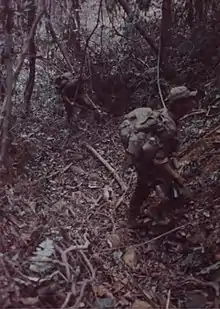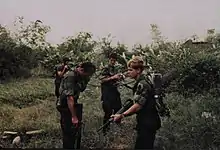| Tiger Force | |
|---|---|
 Patch of the Tiger Force of United States Army's 101st Airborne Division | |
| Active | November 1965 to November 1969 (Vietnam) |
| Country | |
| Branch | United States Army |
| Type | Special Operations Forces |
| Size | 45 |
| Part of | U.S. XVIII Airborne Corps |
| Garrison/HQ | Fort Campbell (1st Battalion, 327th Infantry Regiment, 1st Brigade) |
| Engagements | Vietnam War |
| Decorations | |
| Commanders | |
| Notable commanders | David Hackworth |
Tiger Force was the name of a long-range reconnaissance patrol unit[1] of the 1st Battalion (Airborne), 327th Infantry, 1st Brigade (Separate), 101st Airborne Division, which fought in the Vietnam War from November 1965 to November 1967.[2]: 22–3 The unit gained notoriety for their successes in fighting communists.[3]
Composition

The platoon-sized unit, approximately 45 paratroopers, was organized by Major David Hackworth in November 1965 to "outguerrilla the guerrillas".[2]: 13–14, 23, 224 Tiger Force (Recon) 1-327th was a highly decorated small unit in Vietnam, and paid for its reputation with heavy casualties.[4] In October 1968, Tiger Force's parent battalion was awarded the Presidential Unit Citation by President Lyndon B. Johnson, which included a mention of Tiger Force's service at Đắk Tô in June 1966.[5]
Investigations of war crimes

On October 19, 2003, Michael D. Sallah, a reporter at The Blade (Toledo) newspaper, obtained unreleased, confidential records of U.S. Army commander Henry Tufts. One file in these records referred to a previously unpublished war crimes investigation known as the Coy Allegation. To investigate this further, Sallah gained access to a large collection of documents produced by the investigation held at the National Archives in College Park, Maryland.[2]: 309–11 [6]
Sallah found that between 1971 and 1975, the Army's Criminal Investigation Command had investigated the Tiger Force unit for alleged war crimes committed between May and November 1967.[2]: 264–306 The documents included sworn statements from many Tiger Force veterans, which detailed war crimes allegedly committed by Tiger Force members during the Song Ve Valley and Operation Wheeler military campaigns. The statements, from both individuals who allegedly participated in the war crimes and those that did not, described war crimes such as the following:
- the routine torture and execution of prisoners[2]: 337, 344–5, 349, 353, 370–2
- the routine practice of intentionally killing unarmed Vietnamese villagers including men, women, children, and elderly people[2]: 335, 339–346, 350–2, 354–5, 359, 361–2, 367–9, 374–5, 376
- the routine practice of cutting off and collecting the ears of victims[2]: 335–6, 371
- the practice of wearing necklaces composed of human ears[2]: 371
- the practice of cutting off and collecting the scalps of victims[2]: 346, 374
- incidents where soldiers planted weapons on murdered Vietnamese villagers[7]
- an incident where a young mother was drugged, raped, and then executed[2]: 361–2, 377–8
- an incident where a soldier killed a baby and cut off his or her head after the baby's mother was killed[2]: 360, 363–4, 372–3
The investigators concluded that many of the war crimes took place.[2]: 383 This included the murder of former-ARVN personnel, the murder of two blind brothers, the crippled and old and the routine murder of women and children.[3] Despite this, the Army decided not to pursue any prosecutions.[2]: 306
Their high bodycounts were recognized and encouraged by military officials. Colonel Morse ordered troops to rack up a body count of 327 casualties in order to match the battalion's infantry designation, 327th;[3] however by the end of the campaign soldiers were congratulated for their 1000th kill.[8] Those killed were listed as enemy combatants.[3]
After studying the documents, Sallah and fellow reporter, Mitch Weiss, located and interviewed dozens of veterans who served in Tiger Force during the period in question as well as the CID investigators who later carried out the Army's inquiry. The reporters also traveled to Vietnam and tracked down numerous residents of Song Ve Valley who identified themselves as witnesses. Sallah and Weiss reported that the war crimes were corroborated by both veterans[9] and Song Ve Valley residents.[10] The reporters also managed to track down dozens of additional investigative records not included in the National Archives.
The reporters published their findings in a series of articles in The Toledo Blade[11] in October 2003. The New York Times subsequently performed their own investigation, contacting a few Tiger Force veterans and corroborating The Toledo Blade's findings.[12]
Since The Blade's story, the United States Army has opened a review of the former Tiger Force investigation, but has not yet provided much additional information. On May 11, 2004, Lt. Col. Pamela Hart informed The Blade reporters that she had been too busy responding to prisoner abuse by U.S. soldiers in Iraq to check on the status of the Tiger Force case.[13] The Blade has not reported on any more recent updates from the U.S. Army.
Reporters Michael D. Sallah, Mitch Weiss, and Joe Mahr received a number of awards for their series:
- In 2003, the reporters won the IRE Medal.[14]
- In 2003, the reporters won the Sigma Delta Chi Award for investigative reporting, for publications with a circulation of 100,000 or greater.[15]
- In 2004, the reporters won the Taylor Family Award for Fairness in Newspapers.[16]
- In 2004, the reporters won the Pulitzer Prize for Investigative Reporting.[17]
In 2006, Sallah, now an investigative reporter with The Washington Post, and Weiss, an investigative reporter with the Associated Press, co-authored a book chronicling their findings: Tiger Force: A True Story of Men and War (2006).[2]
Notable former members 1965–1969
- Lt. Col. David Hackworth,[2]: 13 unit founder
- Lt. Dennis Foley
- Lt. James Hawkins (implicated in leading nearly all controversial events)[2]: vii–xi Hawkins was a battlefield-commissioned second lieutenant. Hawkins attributes the lack of charges to the timing of the investigation after My Lai and Bumgarner the potential for additional bad "publicity."[2][6]
- Lt. James A. Gardner (awarded the Medal of Honor, posthumously) killed in action, before any of the controversial events
- Lt. William F. Kernan
- Lt. Donald Wood[2]: vii–xi (whistleblower)
- Lt. Skip Franks[2]: vii–xi (whistleblower)
- Ssg. John G. Gertsch (awarded the Medal of Honor, posthumously) killed in action
- Sgt. Gerald Bruner[2]: vii–xi (whistleblower)
- Spc. William Carpenter[2]: vii–xi (whistleblower)
- Spc. Kenneth Leon Green, killed in action
- Pvt. Rion Causey[2]: vii–xi (whistleblower)
- Pvt. Kenneth Kerney[2]: vii–xi (whistleblower)
- Pvt. Sam Ybarra[2]: vii–xi
In popular culture
- In the 2014 book Edge of Eternity by Ken Follett, character Jasper Murray is enlisted in the military and assigned to Tiger Force in Vietnam. He witnesses and is forced to participate in several war crimes, such as rape and murder of a Vietnamese family and using Vietnamese peasants as "mine dogs" to detect mines and traps laid by Viet Cong.
See also
- Vietnam War
- Phoenix Program
- Operation Speedy Express
- Former United States special operations units
- Vietnam War Crimes Working Group Files
- Broader, related topics
References
- ↑ Rottman, Gordon (2008). US Army Long-Range Patrol Scout in Vietnam 1965-71. Osprey Publishing. p. 33.
- 1 2 3 4 5 6 7 8 9 10 11 12 13 14 15 16 17 18 19 20 21 22 23 24 Sallah, Michael; Weiss, Mitch (2006). Tiger Force: A True Story of Men and War. Little, Brown and Company. ISBN 0316159972.
- 1 2 3 4 Ward, Geoffrey C.; Burns, Ken (2017). The Vietnam War: An Intimate History. Knopf Doubleday Publishing Group. pp. 235–8. ISBN 9781524733100.
- ↑ Joe Mahr (28 March 2004). "Unit's founder says he didn't know of atrocities". Toledo Blade. Archived from the original on 7 January 2010. Retrieved 4 December 2008.
- ↑ U.S. Army, "101st Airborne Division, Unit Decorations War Department General Orders 59, 21 October 1968". U.S. Army.
- 1 2 Oliver, Kendrick (2007). The My Lai Massacre in American History and Memory. Manchester University Press. p. 328. ISBN 978-0-7190-6891-1.
- ↑ "The Vietnam War Crimes You Never Heard Of". hnn.us. Retrieved 4 October 2017.
- ↑ Michael Sallah; Mitch Weiss (22 October 2003). "Rogue GIs unleashed wave of terror in Central Highlands". Toledo Blade.
- ↑ Michael Sallah; Mitch Weiss (22 October 2003). "Pain lingers 36 years after deadly rampage". Toledo Blade.
- ↑ Sallah, Michael D.; Weiss, Mitch; Mahr, Joe (2003). "Tiger Force columns in order of appearance in the original entry". Toledo Blade. Retrieved 30 September 2017.
- ↑ John Kifner (December 28, 2003). "Report on Brutal Vietnam Campaign Stirs Memories". The New York Times.
- ↑ Joe Mahr (12 May 2004). "Tiger Force answers still elusive". Toledo Blade. Archived from the original on 30 March 2008. Retrieved 4 December 2008.
- ↑ "IRE Contest | the IRE Awards". Archived from the original on 2006-12-12. Retrieved 2006-12-10.
- ↑ "SPJ Announces Recipients of 2003 Sigma Delta Chi Awards - Society of Professional Journalists". www.spj.org. Retrieved 4 October 2017.
- ↑ "Archived copy". Archived from the original on 2006-09-08. Retrieved 2006-12-10.
{{cite web}}: CS1 maint: archived copy as title (link) - ↑ "The Pulitzer Prizes".
Further reading
- Sallah, Michael and Mitch Weiss. "Investigators will question ex-GIs about killing spree Archived 2008-03-30 at the Wayback Machine." Toledo Blade, 15 February 2004.
- Greiner, Bernd. Krieg ohne Fronten: Die USA in Vietnam. Hamburg: Hamburger Edition, 2007, ISBN 9783936096804.
- "Tiger Force leader could face charges". Pittsburgh Post-Gazette. 2004-09-05. p. 17. Retrieved 2020-12-29 – via Newspapers.com
 .
. - "Killer Instinct". ABC News. Retrieved 2020-12-29.
- Colarossi, Anthony (8 September 2004). "Area Veteran Accused of Atrocities During Vietnam". Orlando Sentinel. Retrieved 2020-12-29.
External links
- Report at pulitzer.org of award for Toledo Blade articles
- Tiger Force veterans' website
- Michael Sallah interviewed on Democracy Now!
- Michael Sallah and Mitch Weiss interviewed on NPR's Talk of the Nation
- Michael Sallah interviewed on NPR's On The Media
- Interview with Sallah and Weiss at the Pritzker Military Library